Edwin Fox Bimble

Beez Neez now Chy Whella
Big Bear and Pepe Millard
Fri 19 Sep 2014 21:57
|
A Bimble Around The Edwin
Fox  Here we are in Picton, a few hours before our ferry, time to visit the
Edwin Fox.
 We stood outside looking at the shed that houses this famous lady
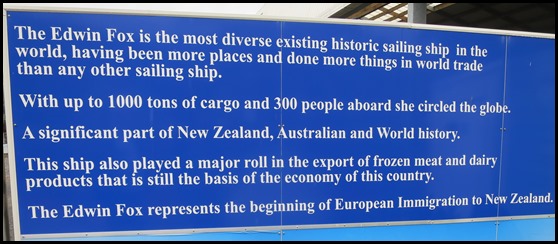 The information
board certainly wet our whistles.
 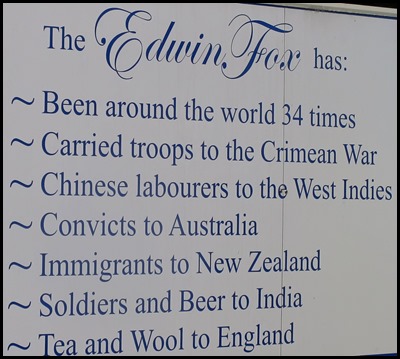 Some very impressive statistics.
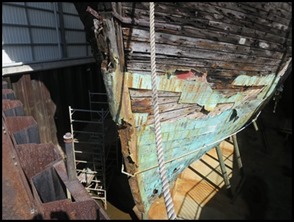  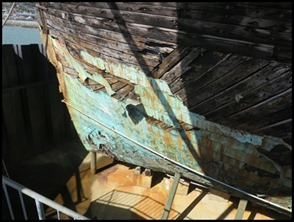 We were met at the entrance by a
couple of lovely ladies, they suggested we visit the ship and then look around
the museum, sounded like a good way to go about things. We began at the front. The Edwin Fox was towed to Picton from Lyttelton
in 1897 to become part of the early frozen meat industry. She served as a
refrigeration and storage hulk to the turn of the century and finished her
working life as a coal storage hulk in the 1950’s. She was beached in
Shakespeare Bay in 1967, refloated in October 1986 and remained afloat until she
was finally dry docked here on the 18th of May 1999. At her peak her vital
statistics were:- Weight eight hundred and thirty six tons. Length one hundred
and forty four feet, six inches. Beam twenty nine feet, six inches. Draft twenty
three feet, six inches. Unbelievable condition for her age and
history.
 Her rear
end, still showing her original depth indicators.
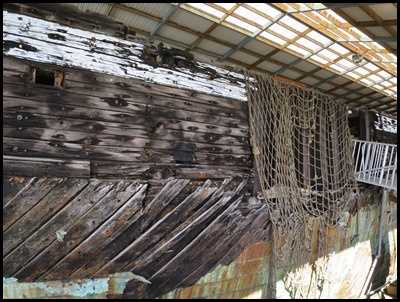 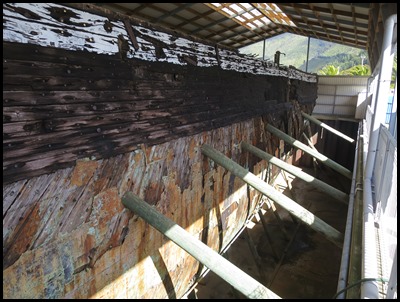 We walked her port
side.
Gangway entrance – seen on left
picture. During her time as a sailing ship, there was no entry to the Edwin Fox
at this level. Instead, longer, steeper gangways gave access to the main deck
above. When she was converted to a coal hulk next to the Picton freezing works,
a hole was cut into the side of the ship at this point to allow coal trucks to
drive aboard. The current entrance uses part of this hole. The rest of the hole
has been planked on the inside, but left uncovered on the outside, to preserve
this aspect of the ship’s varied life. We read this notice and aboard we
went......................
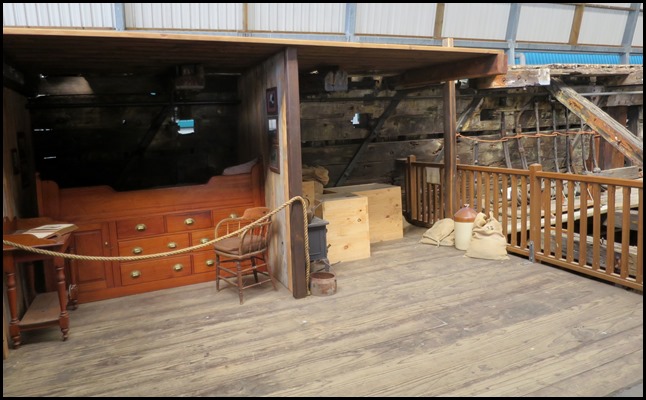 Main Deck: This deck
covered the deck we are standing on, known as the ‘between
deck’. Effectively, this was the ceiling above the bunks of the steerage
class passengers. Most of the main deck planking, and many of the beams were
removed when the ship lay abandoned in Shakespeare Bay. These planks and beams
were recycled and used by local ship builders. Part of the main deck has been
replaced, to allow visitors to the ship to experience the closed-in conditions
of steerage class.
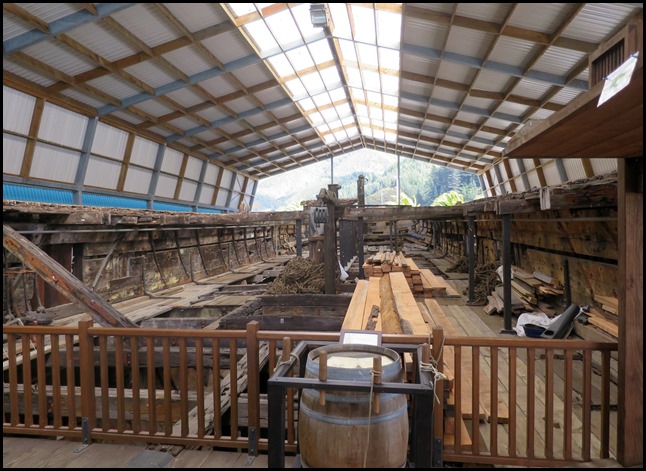 .......................nothing could have been a bigger surprise. So much intact after all these years.
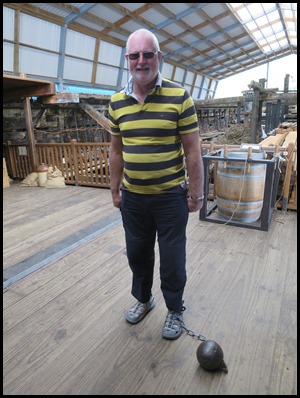 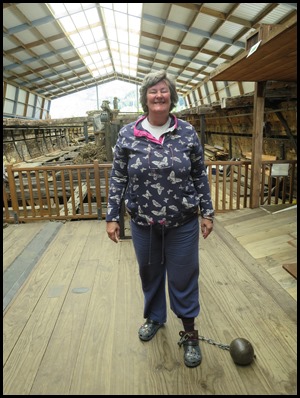 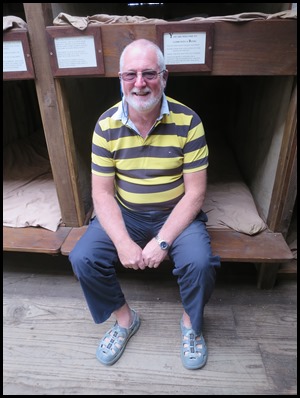 Soon
we were pretending to be convicts, fancy struggling in a ball and chain on a pitching sea....... Then Bear sat on
his bunk.
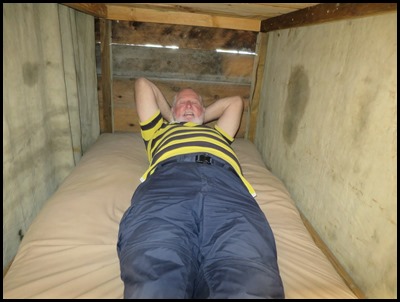 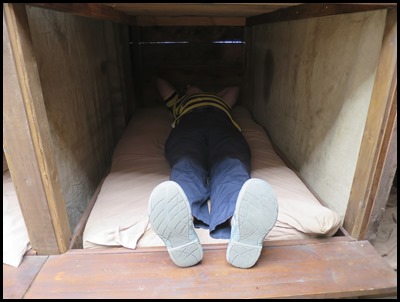 Bear settled
in. The flash gave light in the ‘bedroom’. The next shot was taken
without, considering there is no roof we can picture just how dark and dismal
things were. We pictured what it would be like to lay on a straw mattress,
smelling the sea and the old timbers. Water would often drip through the decking
that wet the bedding. The rectangular port holes were closed during rough
weather, sickness spread easily. The ‘shelf’ on the end of the bunk was used as
a seat and as a step up to the top level. At the end of the voyage immigrants
dismantled these bunks, the timbers were used in their first homes.
Steerage class was
the cheapest accomodation, with the worst food and conditions. Each unit was for
a family of up to six people, mum, dad and four children. We can only imagine
what it was like having three people sleeping ‘top and tail’ on each level, in
dark, damp smelly spaces on a straw filled mattress for a twelve to fourteen
week passage.
 Steerage class menu: Breakfast – Boiled rice or porridge and tea.
Midday dinner – Pea soup, preserved potatoes and tinned vegetables. Three
days a week, there was a stew made with salted meat instead of soup. Sometimes
there was a suet and raisin pudding. Evening meal – soup and ships biscuits or
bread and a cup of tea.
Steerage Class Table: Tables and forms
such as these ran down the centreline of this deck. People sat here to eat their
meals, do hand crafts, write letters or diaries, do school lessons or play cards
and board games. Clothes lines, clothing and equipment hung from above. Crockery
and glass bottles of preserved jam and pickles were secured in the central rack.
The raised table edge helped prevent plates, mugs and cooking containers from
sliding off the table as the ship moved.
Lighting: During the day, in calmer
seas, the hatch covers were open to allow light and fresh air to enter the
between deck. At night, hurricane lanterns were used sparingly, as the fuel was
rationed. A fallen lantern could set fire to these wooden hulled ships with
tragic consequences. A large weather proof lamp was used to light the ship’s
compass alongside the helm, near the stern – steering position.
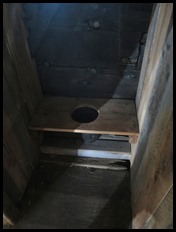 The Edwin Fox normally had six to
eight bucket toilets like this one, to be shared by
over two hundred steerage class people, cabin class and officers had a better
ratio. Toilet paper did not exist. Families were rostered to do toilet cleaning
and emptying duties. There was no fresh water for washing bodies or clothes.
Body washing was done in screened areas on the main deck using buckets of sea
water. Disease and skin sores spread easily. In the tropics, the heat and smell
of unwashed bodies made life in steerage class very unpleasant. In the cold
waters south of New Zealand there was no heating of the cabin areas, clothing
and bedding did not dry easily.
Sickness in Steerage Class: This area
was often crawling with ticks, cockroaches and rats. There were outbreaks of
serious diseases such as measles, diphtheria, scarlet fever, typhoid, small pox
and tuberculosis, the youngest passengers were often the hardest hit. Fumigation
with vinegar and cayenne pepper was mostly ineffective. The ships surgeon would
dispense ‘medical comforts’ such as stout, sherry, sago, port, milk and
preserved potato to those with illness. Sea
sickness was treated with bucketfuls of gruel – thin porridge made with oatmeal
and boiling water and brandy. The dead were wrapped in canvas and buried at
sea.
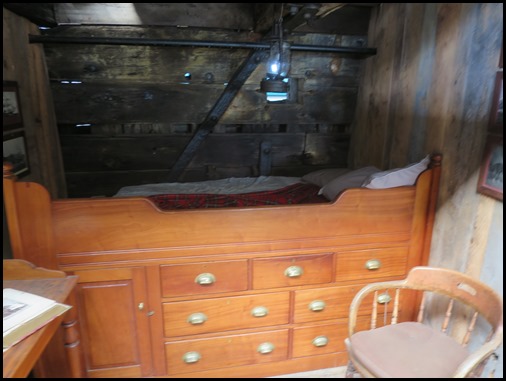 Cabin Class: Was the equivalent of
first class travel of the time, but certainly not up to current standards. This bed, for one or two people, was in a cabin, up a deck,
near the stern of the ship. There was more space, about six feet by eight feet
six, better air, lighting and food. There was privacy in relative comfort and
these passengers had no on-board duties. Cabin class could carry more luggage
and furniture with them, they mixed with the captain and officers, and often
avoided the ‘steerage class’. A ship of this size could have about twenty cabin
class passengers to around one hundred and eighty steerage class.
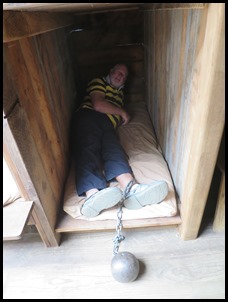 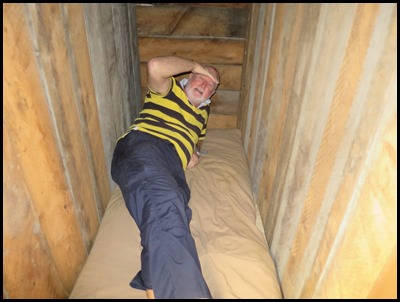  Over one
thousand ship loads of convicts were sent to Australia. The Edwin Fox made one voyage carrying convicts in 1858 from
Britain to Freemantle in Western Australia. This second level cell replicates a typical cell of the time, eventually the
museum plans to add the door with bars. Most of this between deck space was
filled with these cells. A further cell deck was fitted into part of the hold.
Groups of prisoners in leg irons were taken up to the main deck for exercise and
washing. Conditions were very grim but the convicts mostly, had a much better
life in Australia than back in the prison ships moored in British
harbours.
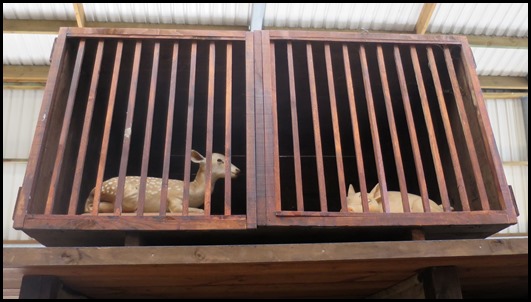 Stock
Crates: The Edwin Fox normally carried chickens, sheep, pigs, goats and
cows to supply fresh eggs, milk, butter and meat for the officers and cabin
passengers, these were kept in crates of a suitable size on the central deck
area. Animal wastes mixed with rain or salt water
could leak through the deck onto the bunks below. Other animals were carried as cargo to become breeding stock for the
new settlements in New Zealand. This is hoe sparrows, starlings, blackbirds,
turkeys, rabbits, hares, stoats, hedgehogs, horses and trout arrived here.
When fresh water was short for all on-board,
these animals suffered and sometimes died.
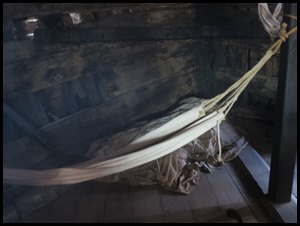  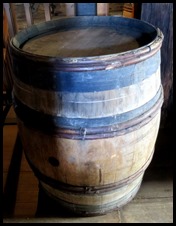 Hammocks: This
hammock is a copy of those used and is a replica of Captain Cook’s HMS
Endeavour based in Sydney. Each crew member had his own hammock, which rolled up
into a ‘sausage’ shape when not in use. Dirty hammocks were scrubbed with sea
water and dried on deck on a warm day. Each crew member also had a wooden sea chest, to store belongings in and to use as a
seat.
Wooden
Barrels: The Edwin Fox’s water supply was held
in barrels, it was important that they did not leak. Water was rationed and
given out daily. Water was locked away in the hold to avoid theft. Some of the
water was used to soak the salted meat. Rain water was collected to supplement
supplies. Barrels were also used to hold salted beef, salted pork, rum, brandy,
ships biscuits, butter and oils. These supplies had to last the voyage time of
three to four months. Barrels were moved between decks, through the hatchways,
using ropes and blocks. The ships owners avoided calling in at ports such as
Cape Town in South Africa to take on fresh supplies as crew could abscond and
cause an expensive hold-up.
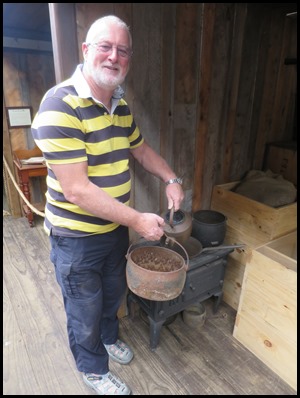 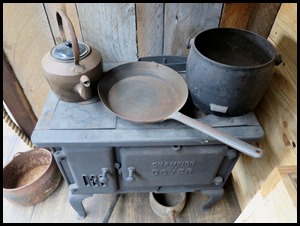 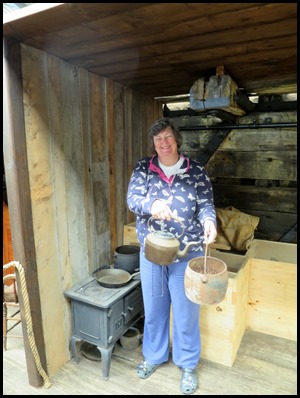 Bear did make a fuss hefting the cookware. It’s really
heavy. I was thrilled to see the stove was made
by Champion of Dover in Kent. Of course I happily showed how women do it without so much as a second
thought...........
 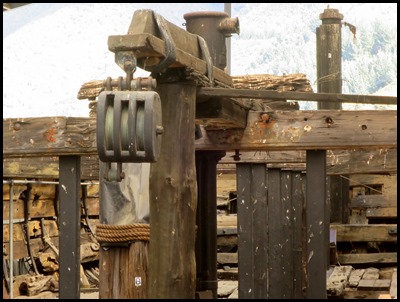 We stood for a while looking over the
protective rail and were amazed at the condition of the bits
and bobs we saw.
 Next we went to
have a good look ‘downstairs’.
ALL IN ALL A GREAT
LADY
AMAZING
PRESERVATION |